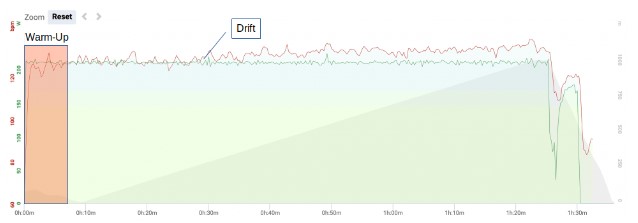
For Z1-Z2 exercise there is a coupling of speed or power to HR. For a constant power/speed the HR should settle down to a constant value after a few minutes warm-up. At some point the HR may start to increase slightly. This is cardiac drift and it means is the heart is not pumping as much blood (stroke volume) for each beat and as a consequence the heart rate has to increase. One cause is a rise in core temperature, the body directs some blood to the outer body and as a result there is a drop in blood pressure on the return side of the heart. For each contraction the heart fills with less blood and the heart rate needs to rise to pump the same overall volume.

The point where drift starts to occur can be taken as an initial sign of fatigue. It will occur sooner for higher heart rates wrt to HRmax. This brings us around to the question of how long Z1 sessions need to be. At close to the LT1 limit (80% of HRmax) you will be able to train less before getting tired. At heart rates around 60% of HRmax you will be able to train longer but the overall level of work will be similar to the harder session. At some level of work, below say 55% HRmax, the adaptations of the body to exercise will be negligible.
Seiler suggests a target of 60% of HRR (Heart Rate Reserve). So for a cyclist with a HRmax of 185bpm and a HRrest of 52bpm this gives
which is 70% of HRmax
if LT1 is calculated as 148 we will easily be in zone 1 even if there is some doubt about our LT1 HR without laboratory testing.
⬅ Calculating LT2 and HRmax | ⬆ Contents | Heart Rates Zones ➡